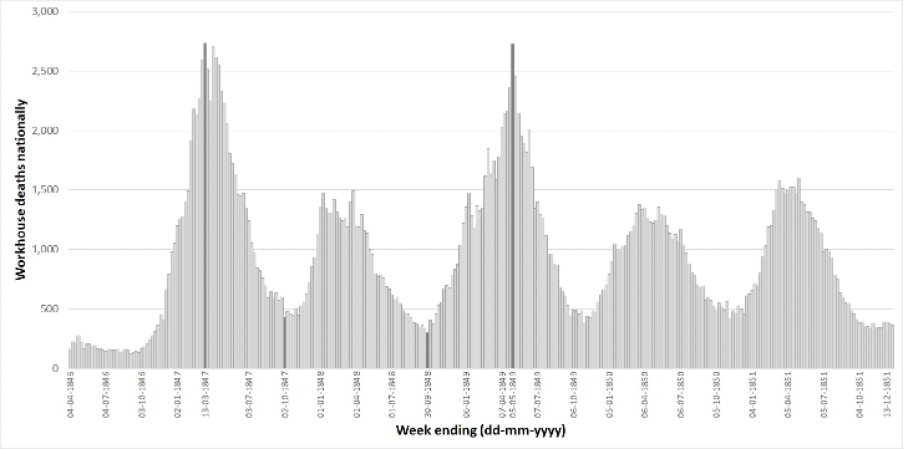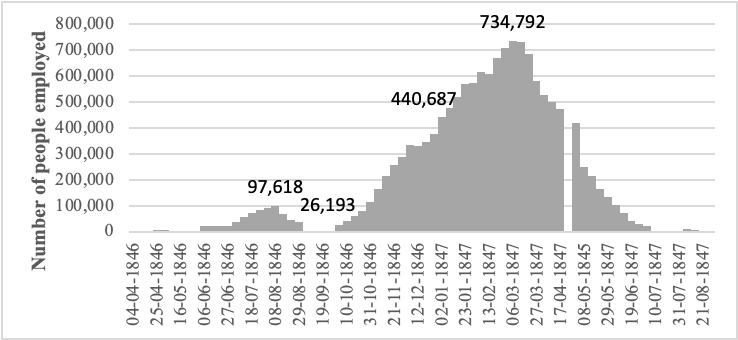
Our new book, ‘The Death Census of Black ‘47’, is out this month. It will be open access. But what was the Death Census, why was it created, and what does it tell us? 🧵
Co-authored with @LewisDarwen @BrianGurrin
#IrishHistory #GreatIrishFamine #Bookstore #BooksWorthReading
Co-authored with @LewisDarwen @BrianGurrin
#IrishHistory #GreatIrishFamine #Bookstore #BooksWorthReading

First, some context. The Great Famine was caused by successive failures of the potato crop in the later 1840s, the main and often only source of food of the labouring classes. The cause was an invasion by an unknown airborne fungal disease, known then as ‘the blight’.
Conditions were worsened by the weakness of govt responses. But only after a second crop failure 1846 that the suffering grew drastically. Between late 1846 and 1848, an estimated 1m Irish people died of disease and starvation.
DEP, 9 Sept 1845 announces the deadly arrival:
DEP, 9 Sept 1845 announces the deadly arrival:

By the autumn of 1846, Ireland’s workhouses were overcrowding, fevers were ripping through the S & W of the country, and a mass exodus began. There were riots, but mostly the populace was too weak to fight. In addition to those who perished, more than 1m left permanently. 

Robert Peel’s government initially responded swiftly, secretly purchasing maize in the autumn of 1845 for gradual release on the market in Ireland, and setting up public works schemes to provide work and wages to the suffering population.
Average daily employment on Public Works
Average daily employment on Public Works

The fall of his government in 1846, however, saw a switch in relief policy under the new Whig Prime Minister, John Russell. Russell’s ministry were devotees of political economy, and refused to intervene in the import and export of food from Ireland.
Soup kitchens:

Soup kitchens:


Historians accept that Russell’s government could have done much more to save lives during the height of the crisis in Black ‘47, and it is against this backdrop that we can begin to understand the creation of the Death Census.
Proposed in April 1847 by John O’Connell, Irish MP and leading figure in his father Daniel’s Repeal Association, the Death Census was a survey of mortality in Ireland which sought to expose the number of people who had perished as a result of famine. Why?
By early 1847 many in Ireland were perplexed by the direction of the government’s relief efforts, and believed that ministers had not grasped the full extent of the crisis. They held out hope that, by exposing those realities, the government might change course.
But the Death Census also was a political act. John O’Connell’s Repeal Association was created to push for independence: if it could be shown that the British government’s policies had led to the deaths of thousands, perhaps millions, it would aid the case for independence.
So, the Death Census must be understood in terms of immediate concerns about famine relief, and the wider political campaign for the repeal of the Act of Union of 1800.
The politics of mortality during the Famine has been largely overlooked by historians. As we show in the book, the Death Census was one of several efforts to count deaths to expose the inadequacies of government policy. As Covid-19 recently showed, mortality crises ARE political.
The Death Census is made up of responses to a circular questionnaire sent to Catholic clergymen across Ireland. They were asked to provide the number of deaths in their parish between 1st Oct ’46 and 1 April ’47, and during the same period the year previously.
The intention was to show mortality during a relatively ‘normal’ time, and during the prevailing famine. In this way, the extent of excess mortality would be revealed. The figures show astonishing levels of excess mortality in most parishes.
Clergymen also presented mortality figures alongside grim testimony detailing conditions in their parishes. The Census features 100 returns consisting of over 50,000 words, providing a unique view from the parish level.
Parishes with Surviving Death Census Returns (by Diocese)
Parishes with Surviving Death Census Returns (by Diocese)

Our book features 6 contextual and analytical chapters, and a transcription of the entire Death Census IN FULL. This survey has never been compiled in composite form, and up to this point its existence has been almost entirely overlook by historians.
Over the next few days, and in anticipation of the book’s release in open access form later in the month, we will be tweeting excerpts from the what the priests said in the Death Census.
We hope you enjoyed this first thread. Would you please RT if you did? Thanks for reading.
We hope you enjoyed this first thread. Would you please RT if you did? Thanks for reading.
• • •
Missing some Tweet in this thread? You can try to
force a refresh






